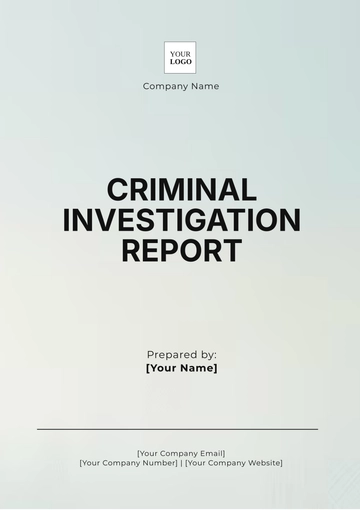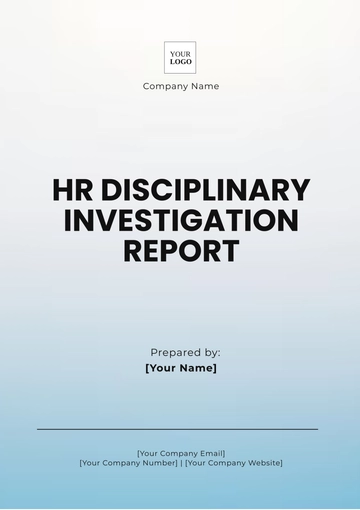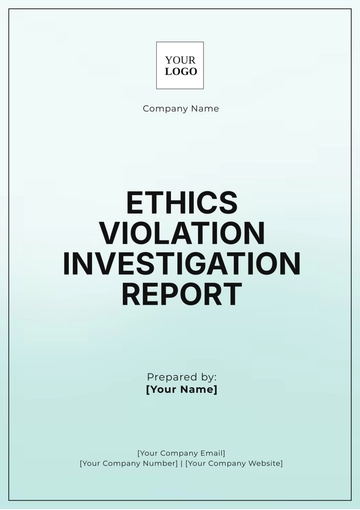Free Compliance Investigation Report

Prepared by: [Your Name]
Company: [Your Company Name]
Date: April 20, 2051
Introduction
This Compliance Investigation Report outlines the findings of an investigation conducted in response to allegations of non-compliance with regulatory standards within an organization. The purpose of this report is to document the investigative process, findings, and recommendations to ensure adherence to applicable laws and regulations.
Background
On April 15, 2051, a complaint was received regarding potential violations of environmental regulations under the Clean Air Act. The complaint raised concerns about excessive emissions from the facility and improper documentation of emissions data. In response, a compliance investigation was initiated to assess the validity of these allegations.
Methodology
The investigation was conducted following a systematic approach, which included:
Document Review: A thorough examination of relevant documents, including company policies, procedures, training materials, and compliance records from January 1, 2050, to April 15, 2051.
Interviews: Conducting interviews with key personnel involved in the processes under investigation, including management, operational staff, and compliance officers.
Site Visits: Observing operations at the facility to gather firsthand information about compliance practices and emissions monitoring.
Data Analysis: Analyzing emissions data and compliance metrics for the year 2051 to identify discrepancies and trends.
Findings
1. Non-Compliance Issues
During the investigation, several areas of non-compliance were identified:
Policy Violations: The facility exceeded permissible emission limits for volatile organic compounds (VOCs) on multiple occasions, particularly in the first quarter. Specific instances included emissions data that showed levels 15% above regulatory thresholds.
Training Gaps: Many employees lacked adequate training on environmental compliance topics, particularly regarding emissions reporting and monitoring protocols. A significant percentage of relevant staff did not complete the required training within the last year.
Record-Keeping Deficiencies: There were significant gaps in record-keeping practices, leading to a lack of transparency and accountability in emissions monitoring. Key data was missing from the logs for several weeks, creating challenges in tracking compliance.
2. Contributing Factors
The investigation also uncovered several factors that contributed to the compliance issues, including:
Inadequate Oversight: A lack of consistent oversight from the compliance department resulted in unaddressed violations and insufficient monitoring of operational practices.
Insufficient Resources: The compliance department faced resource constraints, limiting its ability to conduct regular audits and training sessions. This led to gaps in compliance oversight and training effectiveness.
Cultural Challenges: A workplace culture that did not prioritize compliance resulted in a lack of awareness and accountability among staff. Feedback from interviews indicated a perception that compliance issues were not taken seriously, contributing to the overall non-compliance environment.
Recommendations
To address the identified compliance issues and prevent future violations, the following recommendations are proposed:
Policy Reinforcement: Review and reinforce compliance policies to ensure all employees are aware of their responsibilities and the consequences of non-compliance. Implement mandatory periodic reviews of policies to keep them current and effective.
Enhanced Training Programs: Develop comprehensive training programs on environmental compliance regulations and best practices for all employees, particularly those in high-risk areas. Ensure that training is regularly updated and accessible.
Regular Audits and Monitoring: Establish a schedule for regular audits and monitoring of compliance practices to proactively identify issues. Audits should be conducted at defined intervals to ensure continuous compliance.
Strengthening Oversight: Increase oversight by appointing compliance champions within departments who can advocate for adherence to policies and regulations. These champions should be empowered to facilitate communication and training within their teams.
Fostering a Compliance Culture: Promote a culture of compliance through leadership engagement and open communication about the importance of adhering to regulations. Hold regular meetings to discuss compliance issues and foster a sense of shared responsibility among all staff.
Conclusion
The investigation revealed significant compliance issues that must be addressed promptly to mitigate risks and ensure adherence to regulatory standards. By implementing the recommendations outlined in this report, the organization can strengthen its compliance framework and foster a culture of accountability.
- 100% Customizable, free editor
- Access 1 Million+ Templates, photo’s & graphics
- Download or share as a template
- Click and replace photos, graphics, text, backgrounds
- Resize, crop, AI write & more
- Access advanced editor
Unlock precise insights effortlessly with the Compliance Investigation Report Template from Template.net. Tailored for accuracy, it offers a customizable framework and editable fields to streamline your workflow. Seamlessly refine findings using the integrated AI Editor Tool, ensuring compliance with ease. Perfect for detailed reports without the hassle, it’s your go-to solution for meticulous documentation.
You may also like
- Sales Report
- Daily Report
- Project Report
- Business Report
- Weekly Report
- Incident Report
- Annual Report
- Report Layout
- Report Design
- Progress Report
- Marketing Report
- Company Report
- Monthly Report
- Audit Report
- Status Report
- School Report
- Reports Hr
- Management Report
- Project Status Report
- Handover Report
- Health And Safety Report
- Restaurant Report
- Construction Report
- Research Report
- Evaluation Report
- Investigation Report
- Employee Report
- Advertising Report
- Weekly Status Report
- Project Management Report
- Finance Report
- Service Report
- Technical Report
- Meeting Report
- Quarterly Report
- Inspection Report
- Medical Report
- Test Report
- Summary Report
- Inventory Report
- Valuation Report
- Operations Report
- Payroll Report
- Training Report
- Job Report
- Case Report
- Performance Report
- Board Report
- Internal Audit Report
- Student Report
- Monthly Management Report
- Small Business Report
- Accident Report
- Call Center Report
- Activity Report
- IT and Software Report
- Internship Report
- Visit Report
- Product Report
- Book Report
- Property Report
- Recruitment Report
- University Report
- Event Report
- SEO Report
- Conference Report
- Narrative Report
- Nursing Home Report
- Preschool Report
- Call Report
- Customer Report
- Employee Incident Report
- Accomplishment Report
- Social Media Report
- Work From Home Report
- Security Report
- Damage Report
- Quality Report
- Internal Report
- Nurse Report
- Real Estate Report
- Hotel Report
- Equipment Report
- Credit Report
- Field Report
- Non Profit Report
- Maintenance Report
- News Report
- Survey Report
- Executive Report
- Law Firm Report
- Advertising Agency Report
- Interior Design Report
- Travel Agency Report
- Stock Report
- Salon Report
- Bug Report
- Workplace Report
- Action Report
- Investor Report
- Cleaning Services Report
- Consulting Report
- Freelancer Report
- Site Visit Report
- Trip Report
- Classroom Observation Report
- Vehicle Report
- Final Report
- Software Report





























